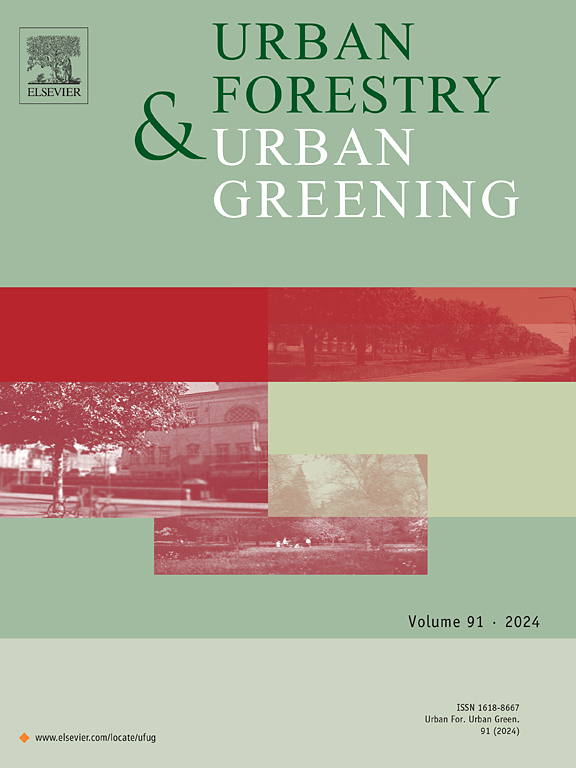Exploring the negative perceptions of tree-based urban green space. People's behaviour and management are crucial
IF 6
2区 环境科学与生态学
Q1 ENVIRONMENTAL STUDIES
引用次数: 0
Abstract
Studies dealing with services and benefits of urban green space are overrepresented compared to those addressing disservices, perceived constraints and other negative perceptions. Even when focusing on disservices and perceived constraints, the studies often take into account only a limited number of reasons for the negative perception. In this study we conducted a series of focus group interviews with the members of the public in the city of Zagreb (Croatia) with the goal of grasping the variety of reasons for negative perception, providing classification of those perceptions and exploring whether and how the perception is related to sociodemographic characteristics. Participants mostly discussed negative perceptions due to the behaviour of other users and perceived inadequate management of urban green space, while the least about the perception of safety. Tree disservices accounted only for a small portion of overall reasons for the negative perception. Age, gender, household income, employment status, number of preschool children and the length of living in Zagreb proved statistically significant for the perception, while education was not. Focus groups as a method enabled cataloguing the variety of reasons for negative perception. Understanding the range of reasons leading to the negative public perception of urban green space contributes to better planning, management and meeting public needs and expectations.
探索对树木型城市绿地的负面看法。人们的行为和管理至关重要
与涉及城市绿地的服务和益处的研究相比,涉及城市绿地的服务和益处、限制因素和其他负面看法的研究所占比例过高。即使研究的重点是负面服务和制约因素,也往往只考虑了造成负面看法的有限几个原因。在本研究中,我们对萨格勒布市(克罗地亚)的公众进行了一系列焦点小组访谈,目的是掌握负面看法的各种原因,对这些看法进行分类,并探讨这些看法是否以及如何与社会人口特征相关。参与者大多讨论了因其他使用者的行为和城市绿地管理不善而产生的负面感知,而对安全感的讨论最少。树木服务不周只占负面看法总原因的一小部分。年龄、性别、家庭收入、就业状况、学龄前儿童人数和在萨格勒布居住的时间长短在统计学上对人们的看法有重要影响,而教育程度则没有影响。焦点小组作为一种方法,可以将导致负面看法的各种原因编成目录。了解导致公众对城市绿地产生负面看法的各种原因,有助于更好地规划和管理城市绿地,满足公众的需求和期望。
本文章由计算机程序翻译,如有差异,请以英文原文为准。
求助全文
约1分钟内获得全文
求助全文
来源期刊

Urban Forestry & Urban Greening
FORESTRY-
CiteScore
11.70
自引率
12.50%
发文量
289
审稿时长
70 days
期刊介绍:
Urban Forestry and Urban Greening is a refereed, international journal aimed at presenting high-quality research with urban and peri-urban woody and non-woody vegetation and its use, planning, design, establishment and management as its main topics. Urban Forestry and Urban Greening concentrates on all tree-dominated (as joint together in the urban forest) as well as other green resources in and around urban areas, such as woodlands, public and private urban parks and gardens, urban nature areas, street tree and square plantations, botanical gardens and cemeteries.
The journal welcomes basic and applied research papers, as well as review papers and short communications. Contributions should focus on one or more of the following aspects:
-Form and functions of urban forests and other vegetation, including aspects of urban ecology.
-Policy-making, planning and design related to urban forests and other vegetation.
-Selection and establishment of tree resources and other vegetation for urban environments.
-Management of urban forests and other vegetation.
Original contributions of a high academic standard are invited from a wide range of disciplines and fields, including forestry, biology, horticulture, arboriculture, landscape ecology, pathology, soil science, hydrology, landscape architecture, landscape planning, urban planning and design, economics, sociology, environmental psychology, public health, and education.
 求助内容:
求助内容: 应助结果提醒方式:
应助结果提醒方式:


